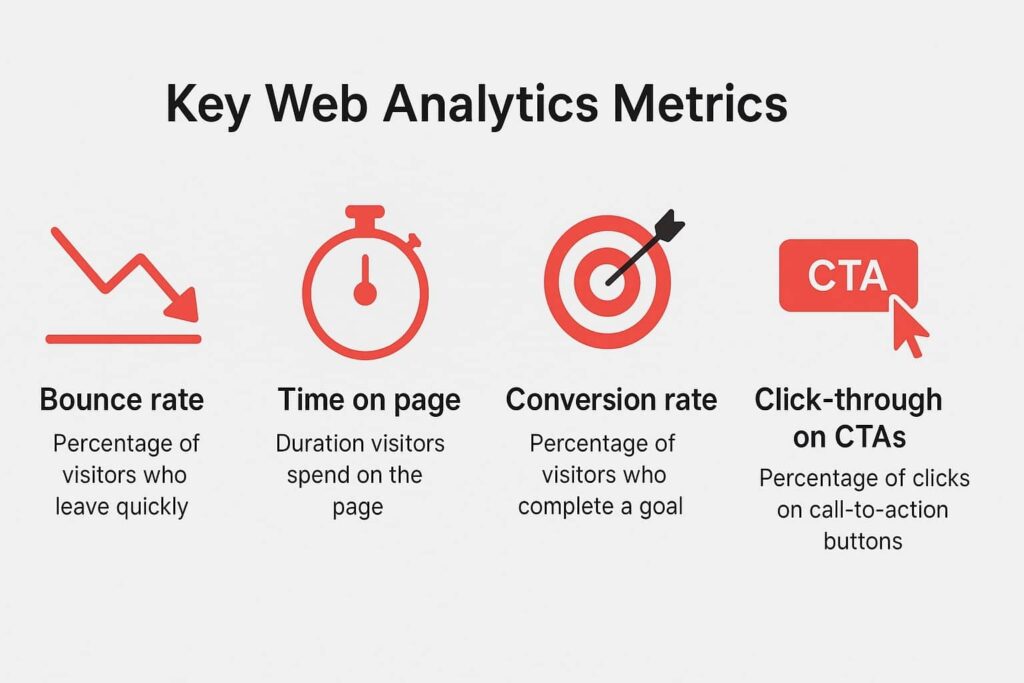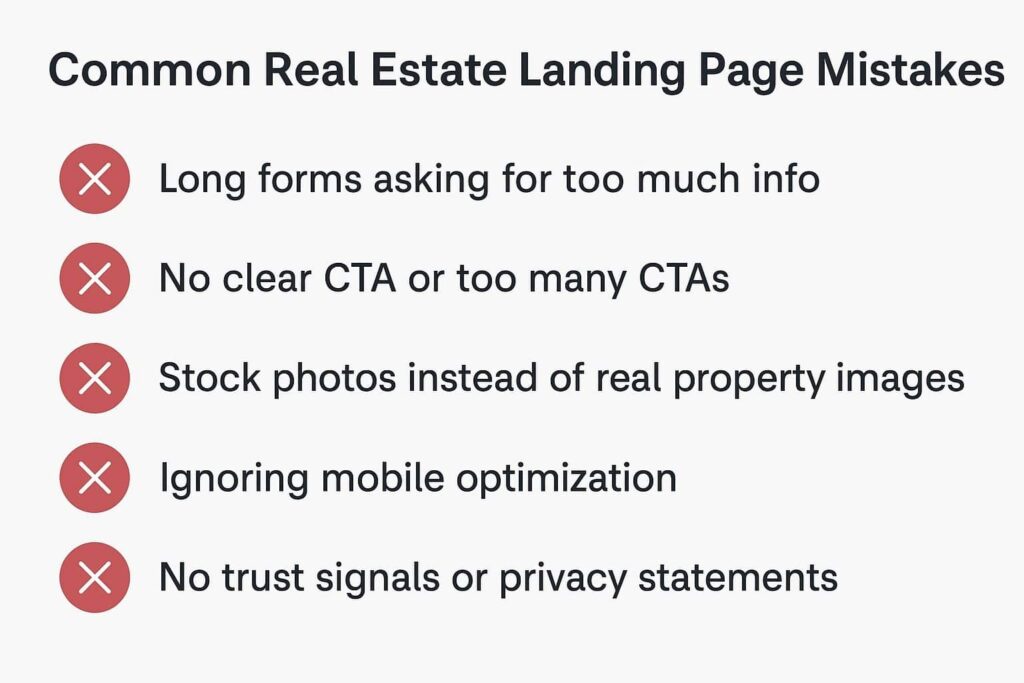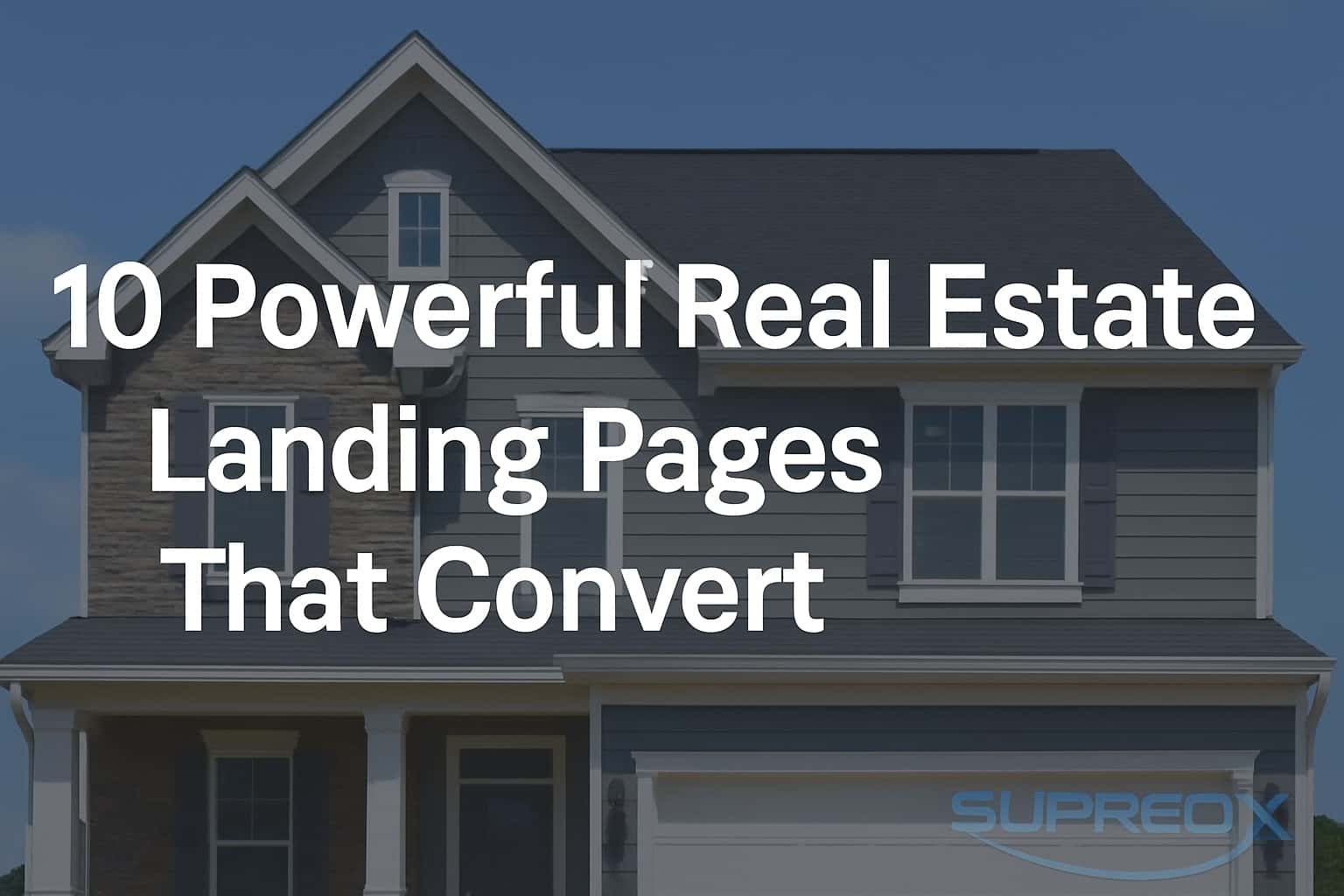The real estate industry has become increasingly competitive in 2025, making it more critical than ever to stand out online. Generic websites no longer cut it. If you’re serious about attracting and converting quality leads, real estate landing pages are essential.
Think of a landing page as your digital open house. It’s not just a place to browse; it’s a place designed specifically to guide visitors toward taking action, whether that’s booking a showing or requesting a home valuation. A great landing page is persuasive, clear, and laser-focused on turning casual visitors into serious prospects.
Understand Your Audience: The Foundation of a High-Converting Page

Before designing your landing page, you must know precisely who you’re targeting. Understanding your audience helps you create a more relevant and compelling experience.
Segment Buyers vs. Sellers
Buyers and sellers have different needs. Buyers are looking for images, detailed descriptions, and information about nearby schools and amenities. Sellers, on the other hand, are focused on how quickly their property can be sold and for what price. Segmenting your audience allows you to tailor your content, layout, and call-to-action perfectly for each group, leading to higher engagement and more conversions.
Match Design to Audience Intent
A young professional searching for a modern condo in the city center will respond to a different design and messaging than a family seeking a spacious suburban home. Matching the visual style and tone of your page to your audience’s preferences ensures that your landing page resonates deeply with them.
Must-Have Elements of Effective Real Estate Landing Pages

Let’s break down the building blocks that make a great page stand out.
High-Quality Property Imagery That Sells
Strong real estate landing pages combine attractive visuals with compelling copy and a user-friendly layout. Every element plays a role in keeping visitors engaged and pushing them toward action.
High-quality imagery is absolutely essential. In real estate, a picture isn’t just worth a thousand words — it can be worth tens of thousands of dollars. Professional photography showcasing a property’s best features, from wide-open living spaces to detailed shots of unique amenities, can dramatically increase interest. Make sure to include various angles, including interior, exterior, and neighborhood photos, to give potential buyers the full picture.
Compelling Property Descriptions with Local Appeal
Once the images capture attention, your property descriptions need to seal the deal. Focus on clear, concise, and emotionally resonant language. Instead of dry facts, paint a vivid scene: “Imagine cozy family evenings by the stone fireplace in your spacious living room.” Always mention important details, such as the number of bedrooms, bathrooms, square footage, and any standout features, like renovated kitchens or proximity to major attractions.
Attention-Grabbing Headlines and Subheadings
Don’t forget the power of headlines. Your headlines and subheadings should be magnetic, making readers want to scroll further. Use action-driven language that taps into emotions and urgency, encouraging visitors to take the next step toward making a decision.
Mobile-Responsive Design: No Excuses in 2025
Today, more than 70% of real estate browsing happens on smartphones. If your landing page doesn’t adapt smoothly to mobile devices, you’re instantly losing potential leads.
How Mobile Experience Impacts Conversions?
A mobile-responsive design ensures your page looks and functions beautifully on any screen size, from smartphones to tablets. This means fast loading times, easy navigation, and buttons large enough for fingers, not just mouse clicks. A poor mobile experience often leads to high bounce rates, while a smooth, attractive design keeps visitors engaged and encourages action.
Tools for Testing Responsiveness
Several tools can help you test mobile responsiveness, including Google’s Mobile-Friendly Test and PageSpeed Insights. Always review your landing page on multiple devices to guarantee a seamless user experience.
Craft CTAs That Capture Real Estate Leads
A real estate landing page without a strong call-to-action is like a house without a front door — there’s no clear way to enter.
CTA Placement Strategy
Your CTA should be bold, visible, and action-oriented. Place it strategically above the fold so visitors don’t have to scroll to find it, and repeat it naturally throughout the page. Use colors that stand out from the rest of the design but still feel harmonious.
Examples of High-Converting CTAs
Action-driven phrases like “Schedule a Home Tour,” “Get a Free Home Valuation,” or “View New Listings Now” clearly tell visitors what to do next. A powerful CTA removes doubt and encourages quick action, increasing your conversion rates significantly.
Optimize Real Estate Landing Pages for SEO
Building a beautiful landing page is only half the battle. Without SEO, your page risks getting buried under the competition.
Keyword Placement & Meta Optimization
Start by conducting keyword research specific to your target market and property type. Naturally weave your main keywords into your headlines, meta descriptions, image alt text, and the first paragraph of your content. This approach helps search engines understand what your page is about without sounding robotic or forced.
Local SEO Tips for Realtors
Local SEO is equally important. Incorporate location-specific phrases like “condos for sale in Austin” or “best neighborhoods in Miami.” Mention nearby landmarks, communities, and attractions to improve your page’s visibility in local searches. Structured data and Google Business Profile integration can also boost your page’s authority and discoverability.
Data Privacy, Security & Trust Signals
Trust is everything in real estate, especially when you’re asking visitors to share personal details like their name, phone number, or email address.
GDPR Compliance for Lead Forms
Ensure that your landing page follows best practices for data protection. Use secure (HTTPS) forms and clearly display privacy policies near any form fields. Let users know how their information will be used, and always request consent, especially if operating in regions governed by GDPR or similar laws.
Add Trust-Builders (Reviews, Badges, Secure Icons)
Adding trust elements such as client testimonials, recognizable brand badges, and secure payment icons can also make a big difference. These signals show visitors that your business is reputable and that their data is safe, easing fears and reducing form abandonment.
A/B Testing and Analytics: Make Smart Improvements
Launching your real estate landing page is just the beginning. To maximize its effectiveness, you need to measure performance and make data-driven tweaks.
Tools Like Google Optimize & Hotjar
A/B testing involves creating two slightly different versions of your landing page — perhaps with a different headline, image, or CTA — and seeing which one performs better. Tools like Google Optimize make setting up A/B tests easy and insightful.
What Metrics to Track

Analytics platforms such as Hotjar and Google Analytics give you deep insights into visitor behavior. By studying heatmaps, click paths, and bounce rates, you can spot opportunities for improvement and fix friction points. Monitoring key metrics, such as conversion rate, time on page, and lead form submissions, helps you continuously refine your strategy for better results.
3 Real Estate Landing Page Templates That Work (2025 Edition)
If you’re looking for a shortcut to success, consider using these proven templates:
Lead Generation Focused Page
The Lead Generation Focused Page prioritizes capturing contact information. It features a strong hero image, a short and punchy value proposition, a lead capture form above the fold, and compelling testimonials that build credibility.
Property Listing Detail Page
The Property Listing Detail Page showcases a single property in-depth. It includes a stunning photo gallery, a map pinpointing the property’s location, a detailed description with key features, and a straightforward CTA encouraging visitors to book a viewing or request more information.
Open House RSVP Page
The Open House RSVP Page is built for events. It highlights the open house date and time, shares enticing reasons to attend, includes a simple RSVP form, and uses a countdown timer to create urgency.
Mistakes to Avoid on Real Estate Landing Pages

Even the best-intentioned landing pages can fail if they make common mistakes.
- Avoid cluttering your page with too many CTAs that confuse visitors.
- Stick to a single, focused goal per page. Refrain from asking for too much information upfront; a simple name and email address will usually suffice to get started.
- Avoid using stock photos when high-quality, real property photos are available. Generic images reduce trust and authenticity.
- Lastly, always prioritize mobile responsiveness and secure your forms to maintain credibility.
Turn Clicks into Closings with Better Landing Pages
Real estate landing pages are more than just digital placeholders — they are powerful marketing tools that can make or break your lead generation efforts. By understanding your audience, presenting stunning visuals, writing irresistible copy, optimizing for search engines, securing your site, and continuously improving through testing, you’ll build landing pages that not only attract visitors but also convert them into loyal clients.
In a crowded market, the difference between a bounced visitor and a closed deal often comes down to your landing page. So, invest the time and effort now to create pages that work just as hard as you do.
FAQs
What is a real estate landing page?
A real estate landing page is a focused web page designed to capture leads by offering specific information or a compelling call-to-action related to buying, selling, or exploring properties.
How do I make my landing page convert better?
Focus on high-quality visuals, a single clear message, a strong and visible call-to-action, and continuous A/B testing to refine what works best for your audience.
Can I use my homepage as a landing page?
Not recommended. A homepage serves too many purposes, while a landing page should have one goal: getting the visitor to take a specific action without distractions.
What should I include on a property listing landing page?
Include a detailed photo gallery, a clear and concise property description, a map showing the location, and a strong CTA that invites visitors to book a tour or request more information.
Are real estate landing pages good for SEO?
Yes! When optimized with relevant local keywords, fast mobile performance, secure forms, and strong metadata, real estate landing pages can attract organic traffic and generate high-quality leads.











